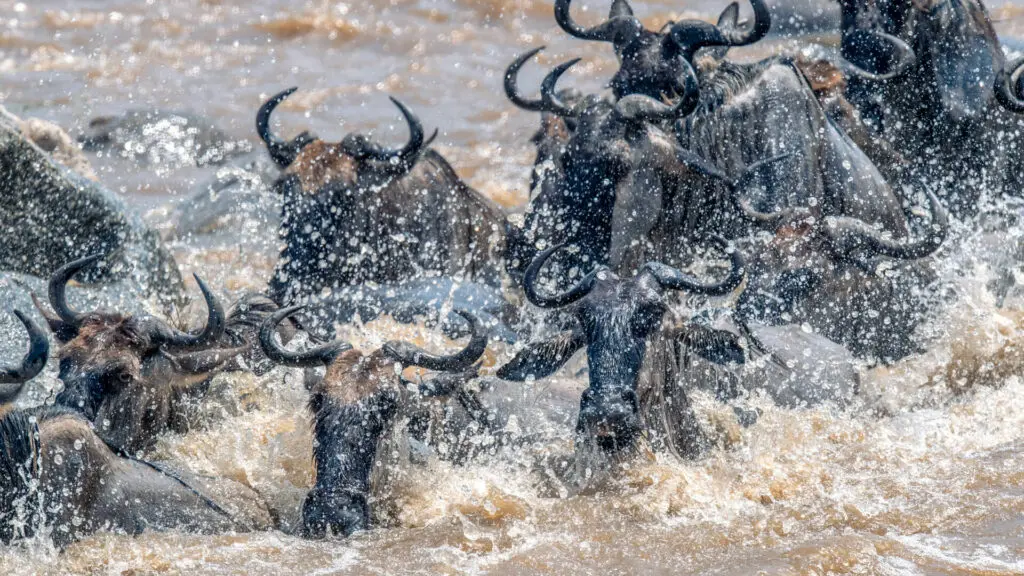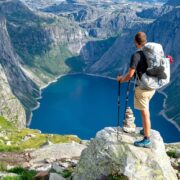
Top 5 Animal Migrations to Witness in East Africa
Why Animal Migrations are the Ultimate Safari Experience

Every year, East Africa pulses with movement. Across vast savannahs and soda lakes, animals follow ancient rhythms shaped by rainfall, survival, and instinct. From the thundering of wildebeest hooves signalling the commencement of the Great Wildebeest Migration to the vibrant sweep of flamingo wings across lake Natron, these animal migrations in East Africa are some of nature’s most gripping dramas.
Few regions on Earth come close to East Africa’s migrations, making witnessing them a truly awe-inspiring experience. That being said, if you want to catch these groups in action, timing is everything. These migrations offer more than just spectacle, they reveal the raw mechanics of life in the wild. Calving seasons bring predators into focus. River crossings expose vulnerability and courage. These are the moments photographers and wildlife lovers chase, and they change with the seasons.
Asilia’s mobile and seasonal camps, such as Olakira Migration Camp and Ubuntu Migration Camp, were designed to follow the action. Positioned to intercept the movements of the migrating herds at strategic points, these camps bring guests to the frontlines of the most extraordinary wildlife movements on the continent.
East Africa’s Most Phenomenal Animal Migrations
1. The Great Wildebeest Migration

Location: Serengeti (Tanzania) to Masai Mara (Kenya)
When to Go: Year-round; river crossings from July to October, calving from January to March
The wildebeest migration is often called the greatest show on Earth, and with good reason. Over a million wildebeest move in a circular route between Tanzania’s Serengeti National Park and Kenya’s Masai Mara, accompanied by zebra and gazelle. It’s the rhythm of East Africa itself, shaped by rain and instinct.
Key events include the calving season on the grassy plains of the southern Serengeti, where newborns attract a dense concentration of big cats. Later in the year, the dramatic crossings of the Grumeti and Mara rivers test the herds’ resolve and attract hungry crocodiles. These moments are raw, cinematic, and unforgettable. For front-row views, consider Sayari Camp in the Northern Serengeti or follow the herds with Ubuntu and Olakira.
2. Zebra Migration

Location: Southern Serengeti, Tanzania
When to Go: December to February
Often in the vanguard of the wildebeest, large herds of zebra migrate along similar corridors but with more linear and structured movement. Their black-and-white bands cut clean silhouettes across golden grasslands, especially during early morning light. This makes the zebra migration a dream for photographers.
During the calving season, zebras cluster around Ndutu, where predators linger nearby. Their journey continues into the central Serengeti as they follow the rains, often moving through the Serengeti with the bulk of the wildebeest herds, but not necessarily going as far north or over the Mara River.
Prime locations to view this migration include Namiri Plains and Olakira Migration Camp, both offering immersive wildlife experiences in less crowded corners of the ecosystem.
3. Flamingo Migration

Location: Lake Natron (Tanzania), Lake Bogoria & Lake Nakuru (Kenya)
When to Go: Usually June to October (depending on water levels)
Few sights rival the arrival of millions of lesser flamingos to East Africa’s soda lakes. As water levels shift and algae blooms flourish, these birds descend in waves, turning entire shorelines shades of rose.
Lake Natron is a vital breeding site, especially between September and November. Its stark beauty, framed by volcanic peaks and mineral-rich flats, makes it one of the most unique settings for birdwatching anywhere in Africa.
This migration pairs beautifully with a northern Tanzania safari, the flamingos providing a unique contrast to the big game of the north. For something extra, enjoy guided hikes around the lake or consider tackling the challenge of summiting Ol Doinyo Lengai for phenomenal views of the surrounding landscape.
4. Elephant Migration

Location: Tarangire National Park, Tanzania
When to Go: June to October (dry season)
During the dry season, thousands of elephants funnel into Tarangire National Park, following age-old trails to the river that bears the park’s name. As other water sources dry up, Tarangire becomes an oasis and a gathering point for family herds, home to one of the highest concentrations of elephants in East Africa.
This is a migration of quiet power, social groups, matriarchs leading young, and juveniles playfully wallowing in the mud beneath towering baobabs.
For intimate elephant encounters, stay at Oliver’s Camp, set in the south of the park in close proximity to the permanent water source of the Silale Swamp.
5. Bat Migration in Zambia

Location: Kasanka National Park, Zambia
When to Go: October to December
Though technically outside East Africa, the bat migration of Kasanka deserves mention. Up to ten million straw-coloured fruit bats gather in a single swamp forest, making this the largest mammal migration on Earth and a truly otherworldly spectacle.
The air is thick with movement at dusk as the bats depart en masse. The sheer scale and sound of this event are unlike anything else. Kasanka can be a thrilling addition to a Southern Tanzania itinerary. Pair it with Ruaha National Park or Nyerere National Park for a more expansive safari experience, ideal for seasoned travellers seeking the uncommon.
Planning Your Safari Around East Africa’s Animal Migrations
Understanding seasonal shifts is key. The dry season (June to October) often concentrates animals around permanent water sources, while the green season (November to May) brings birthing events, lush landscapes, and fewer crowds.
Asilia’s mobile and strategically located camps allow guests to stay close to the action. Whether you’re chasing the wildebeest or watching flamingos on a soda lake, flexibility is your ally.

Each migration has its peak window, and Asilia’s team can help you plan a journey that puts you in the right place at the right time with wildlife-led itinerary planning.
Why Travel with Asilia for a Migration Safari
With camps designed to track wildlife movements and deep roots in each ecosystem, Asilia offers more than accommodation, we offer connection. Whether it’s a mobile camp positioned for river crossings or a permanent lodge in elephant country, every detail is tailored to bring you closer to the story unfolding outside your tent.
Our guiding is expert, our operations are conservation-driven, and our itineraries are personal. From the Serengeti to the Mara, from Tarangire to the Southern parks, we make migration safaris seamless. These trips require planning, insight, and precision.
Let our team build a journey that moves with the rhythm of the wild. Get in touch to start crafting your migration safari.
Recent Posts
Top Safari Activity Alternatives to Game Drives
The Cradle of Mankind: East Africa’s rich history
Africa’s Hidden Safari Gems: Where to Go on Your Second Journey
All Categories

Thailand





